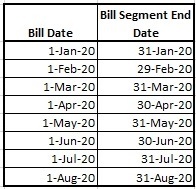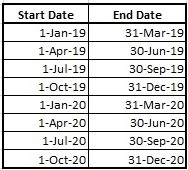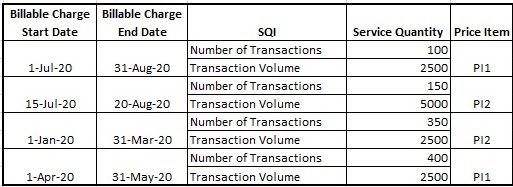Considering SQI Based Billable Charges While Calculating Commitments
The system considers the recurring and non-recurring SQI based billable charges of an account while calculating the original and proposed commitments of the account and customer in a deal. It also considers the recurring and non-recurring SQI based billable charges which are generated through the Transaction Aggregation process (in the Transaction Feed Management (TFM) module).The system does the following while deriving the service quantities from the recurring and non-recurring billable charges of an account:
-
Derives the usage period (i.e. usage start date and usage end date) using the price selection date specified in the deal
-
Considers those SQI based billable charges where the usage start or end date falls within the billable charge start and end dates
-
Calculates the service quantities for the usage period in the deal frequency
The system enables you to derive the service quantities from the recurring and non-recurring billable charges of an account in either of the following mode:
-
Online Mode - If you set the Refer Volume Aggregation option type of the C1-DEAL feature configuration to N, the system derives the service quantities from the recurring and non-recurring billable charges of an account in the online mode. The online mode means that the service quantities from the recurring and non-recurring billable charges of an account are derived for the usage period in the deal frequency at the runtime when you view the pricing and commitment details of the account.
-
Deferred Mode - If you set the Refer Volume Aggregation option type of the C1-DEAL feature configuration to Y, the system derives the service quantities from the recurring and non-recurring billable charges of an account in the deferred mode (i.e. in the background). The deferred mode means when you execute the following batches:
-
Aggregate Account's Volume and Count (PREAGGR) - The Aggregate Account's Volume and Count (PREAGGR) batch derives the service quantities from the recurring and non-recurring billable charges of an account for all deal frequencies (i.e. Monthly, Quarterly, Half Annually, and Annually) and stores the information in the C1_VOLUME_AGGR table. If you want to derive the service quantities from the recurring and non-recurring billable charges of an account in the deferred mode, you need to execute the Aggregate Account's Volume and Count (PREAGGR) batch before creating a deal for an existing account. For more information about the batch, refer to Oracle Revenue Management and Billing Batch Guide.
-
Aggregate Customer's Volume and Count (CSTPREAG) - The Aggregate Customer's Volume and Count (CSTPREAG) batch aggregates the billed service quantities of all accounts of a customer for all deal frequencies (i.e. Monthly, Quarterly, Half Annually, and Annually) and stores the information in the C1_VOLUME_AGGR table. If you want to aggregate the billed service quantities of all accounts of a customer in the deferred mode, you need to execute the Aggregate Customer's Volume and Count (CSTPREAG) batch after executing the Aggregate Account's Volume and Count (PREAGGR) batch. For more information about these batches, refer to Oracle Revenue Management and Billing Batch Guide.
The system then extracts the billed service quantities of an account from the C1_VOLUME_AGGR table while creating a deal. We recommend you to use this mode to experience a better system performance.
-
Considering Recurring SQI Based Billable Charges for Commitment Calculation
Let us understand how the original and proposed commitments are calculated from the recurring SQI based billable charges for a usage period in a deal frequency.
Example 1:
A deal is created for an account named A1 where the deal start date is set to 01-Jul-2020, deal end date is set to 31-Aug-2020, deal currency is set to USD, price selection date is set to 01-Aug-2020, usage period is set to Monthly, and deal frequency is set to Quarterly. Let us assume that the following recurring SQI based billable charges exists for the A1 account where the invoice currency is set to INR:

Now, while calculating the original and proposed commitments, the system derives the service quantities from the recurring billable charges for the usage period in the deal frequency. To derive the service quantities from the recurring billable charges for the usage period in the deal frequency, the system does the following:
-
Derives the usage period (i.e. usage start date and usage end date) using the price selection date and usage frequency in the following manner:
Price Selection Date = 01-Aug-2020 Usage End Date = Price Selection Date = 01-Aug-2020 Usage Start Date = Usage End Date - Usage Frequency = 01-Aug-2020 - 1 Month (i.e. 30 days) = 02-Jul-2020 Usage Period = 02-Jul-2020 to 01-Aug-2020 -
Considers those recurring SQI based billable charges where the usage start or end date falls within the billable charge start and end dates. For example, the system considers the following recurring billable charges of the A1 account:

-
Derives the final start and end dates for the selected billable charges in the following manner:
Final Start Date = Billable Charge Start Date or Usage Period Start Date whichever is later Final End Date = Billable Charge End Date or Usage Period End Date whichever is earlierThe following table indicates the final start and end dates for the selected billable charges:

-
Derives the factor using the final start and end dates and recurring method in the following manner:
Let us assume that the Monthly bill period contains the following schedules:

In such case, the system will derive the factor using the bill period in the following manner:

-
Multiplies the service quantities with the factor in the following manner:
Total Number of Transactions of PI1 = (1000*2) = 2000 Total Transaction Volume of PI1 = (25000*2) = 50000Total Number of Transactions of PI2 = (1500*2) = 3000 Total Transaction Volume of PI2 = (50000*2) = 100000 -
Calculates the service quantities for the usage period in the deal frequency in the following manner:
Number of Transactions of PI1 for the Usage Period in the Deal Frequency = (Total Number of Transactions of PI1 * Deal Frequency)/Usage Frequency = (2000 * 3 (i.e. Quarterly))/1(i.e. Monthly) = 6000 Number of Transactions of PI2 for the Usage Period in the Deal Frequency = (Total Number of Transactions of PI2 * Deal Frequency)/Usage Frequency = (3000 * 3 (i.e. Quarterly))/1(i.e. Monthly) = 9000Transaction Volume of PI1 for the Usage Period in the Deal Frequency = (Total Transaction Volume of PI1 * Deal Frequency)/Usage Frequency = (50000 * 3 (i.e. Quarterly))/1(i.e. Monthly) = 150000 Transaction Volume of PI2 for the Usage Period in the Deal Frequency = (Total Transaction Volume of PI2 * Deal Frequency)/Usage Frequency = (100000 * 3 (i.e. Quarterly))/1(i.e. Monthly) = 300000
In this way, the system derives the original and proposed commitments for the A1 account in the D1 deal.
Example 2:
A deal is created for an account named A2 where the deal start date is set to 01-Jan-2020, deal end date is set to 28-Feb-2020, deal currency is set to USD, price selection date is set to 20-Jan-2020, usage period is set to Annually, and deal frequency is set to Quarterly. Let us assume that the following recurring SQI based billable charges exists for the A2 account where the invoice currency is set to EURO:

Now, while calculating the original and proposed commitments, the system derives the service quantities from the recurring billable charges for the usage period in the deal frequency. To derive the service quantities from the recurring billable charges for the usage period in the deal frequency, the system does the following:
-
Derives the usage period (i.e. usage start date and usage end date) using the price selection date and usage frequency in the following manner:
Price Selection Date = 20-Jan-2020 Usage End Date = Price Selection Date = 20-Jan-2020 Usage Start Date = Usage End Date - Usage Frequency = 20-Jan-2020 - 1 Year (i.e. Annually)= 21-Jan-2019 Usage Period = 21-Jan-2019 to 20-Jan-2020 -
Considers those recurring SQI based billable charges where the usage start or end date falls within the billable charge start and end dates. For example, the system considers the following recurring billable charges of the A2 account:

-
Derives the final start and end dates for the selected billable charges in the following manner:
Final Start Date = Billable Charge Start Date or Usage Period Start Date whichever is later Final End Date = Billable Charge End Date or Usage Period End Date whichever is earlierThe following table indicates the final start and end dates for the selected billable charges:

-
Derives the factor using the final start and end dates and recurring method in the following manner:
Let us assume that the Quarterly invoice frequency contains the following periodic intervals:

In such case, the system will derive the factor using the invoice frequency in the following manner:

-
Multiplies the service quantities with the factor in the following manner:
Total Number of Transactions of PI1 = (1000*1) = 1000 Total Transaction Volume of PI1 = (50000*1) = 50000Total Number of Transactions of PI2 = (500*4)+(750*4) = 2000+3000 = 5000 Total Transaction Volume of PI2 = (2500*4)+(5000*4) = 10000+20000 = 30000 -
Calculates the service quantities for the usage period in the deal frequency in the following manner:
Number of Transactions of PI1 for the Usage Period in the Deal Frequency = (Total Number of Transactions of PI1 * Deal Frequency)/Usage Frequency = (1000 * 3 (i.e. Quarterly))/12(i.e. Annually) = (3000/12) = 250 Number of Transactions of PI2 for the Usage Period in the Deal Frequency = (Total Number of Transactions of PI2 * Deal Frequency)/Usage Frequency = (5000 * 3 (i.e. Quarterly))/12(i.e. Annually) = (15000/12) = 1250Transaction Volume of PI1 for the Usage Period in the Deal Frequency = (Total Transaction Volume of PI1 * Deal Frequency)/Usage Frequency = (50000 * 3 (i.e. Quarterly))/12(i.e. Annually) = (150000/12) = 12500 Transaction Volume of PI2 for the Usage Period in the Deal Frequency = (Total Transaction Volume of PI2 * Deal Frequency)/Usage Frequency = (30000 * 3 (i.e. Quarterly))/12(i.e. Annually) = (90000/12) = 7500
In this way, the system derives the original and proposed commitments for the A2 account in the D1 deal.
Considering Non-Recurring SQI Based Billable Charges for Commitment Calculation
Let us understand how the original and proposed commitments are calculated from the non-recurring SQI based billable charges for a usage period in a deal frequency.
Example 3:
A deal is created for an account named A1 where the deal start date is set to 01-Jul-2020, deal end date is set to 31-Aug-2020, deal currency is set to USD, price selection date is set to 01-Aug-2020, usage period is set to Monthly, and deal frequency is set to Quarterly. Let us assume that the following non-recurring SQI based billable charges exists for the A1 account where the invoice currency is set to INR:

Now, while calculating the original and proposed commitments, the system derives the service quantities from the non-recurring billable charges for the usage period in the deal frequency. To derive the service quantities from the non-recurring billable charges for the usage period in the deal frequency, the system does the following:
-
Derives the usage period (i.e. usage start date and usage end date) using the price selection date and usage frequency in the following manner:
Price Selection Date = 01-Aug-2020 Usage End Date = Price Selection Date = 01-Aug-2020 Usage Start Date = Usage End Date - Usage Frequency = 01-Aug-2020 - 1 Month (i.e. 30 days) = 02-Jul-2020 Usage Period = 02-Jul-2020 to 01-Aug-2020 -
Considers those non-recurring SQI based billable charges where the usage start or end date falls within the billable charge start and end dates. For example, the system considers the following non-recurring billable charges of the A1 account:

-
Derives the former start date and latter end date of the billable charges in the following manner:
Former Start Date = Compare the Start Dates of All Billable Charges and Retain the Earliest Start Date Latter End Date = Compare the End Dates of All Billable Charges and Retain the Latest End DateIn this case, the former start date is 01-Jul-2020 and latter end date is 31-Aug-2020.
-
Derives the number of months between the former start date and latter end date. In this case, the number of months between 01-Jul-2020 and 31-Aug-2020 is 2.
-
Derives the monthly commitments in the following manner:
Monthly Number of Transactions of PI1 = Total Number of Transactions of PI1/Number of Months between Former Start and Latter End Dates = 100/2 = 50 Monthly Number of Transactions of PI2 = Total Number of Transactions of PI2/Number of Months between Former Start and Latter End Dates = 150/2 = 75Monthly Transaction Volume of PI1 = Total Transaction Volume of PI1/Number of Months between Former Start and Latter End Dates = 2500/2 = 1250 Monthly Transaction Volume of PI2 = Total Transaction Volume of PI2/Number of Months between Former Start and Latter End Dates = 5000/2 = 2500 -
Calculates the commitments for the usage period in the deal frequency in the following manner:
Number of Transactions of PI1 for the Usage Period in the Deal Frequency = (Monthly Number of Transactions of PI1 * Deal Frequency)/Usage Frequency = (50 * 3 (i.e. Quarterly))/1(i.e. Monthly) = 150 Number of Transactions of PI2 for the Usage Period in the Deal Frequency = (Monthly Number of Transactions of PI2 * Deal Frequency)/Usage Frequency = (75 * 3 (i.e. Quarterly))/1(i.e. Monthly) = 225Transaction Volume of PI1 for the Usage Period in the Deal Frequency = (Monthly Transaction Volume of PI1 * Deal Frequency)/Usage Frequency = (1250 * 3 (i.e. Quarterly))/1(i.e. Monthly) = 3750 Transaction Volume of PI2 for the Usage Period in the Deal Frequency = (Monthly Transaction Volume of PI2 * Deal Frequency)/Usage Frequency = (2500 * 3 (i.e. Quarterly))/1(i.e. Monthly) = 7500
In this way, the system derives the original and proposed commitments for the A1 account in the D1 deal.
